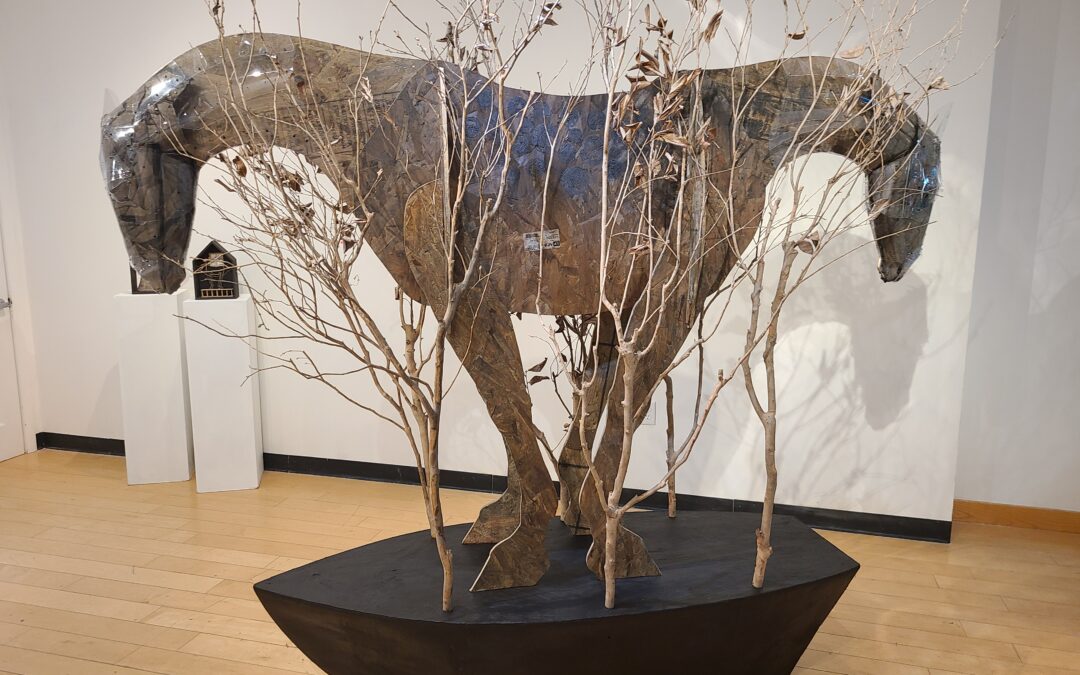By Betsy DiJulio
Janus, the two-faced Roman god, is featured on the discreet, but rather baroque, medallion mounted above the entrance to the American Academy in Rome’s main building (c. 1914) with its austere, symmetrical, and orderly Renaissance architectural vocabulary. Passing through that “threshold” every day while an artist-in-residence at this august research and arts institution, Norfolk-based artist Virginia Van Horn found Janus’s symbolism—beginnings, endings, gates, portals, transitions, passages, choice, duality, and time—imprinted on her psyche and, subsequently, her art.
Located in Gianicolo (Janiculum Hill), the Academy’s context could scarcely be richer in the classical tradition which has informed much of the arc of so-called “western” art. But, other than the oblique reference to Janus in her two-headed horses, Van Horn’s work appears worlds away from its Greco-Roman roots. A champion equestrian in her youth, the artist long ago adopted the horse as a human surrogate. Artistically twinned, the horse becomes a metaphor for the cusp between past and future, seemingly hovering in an eternal present. When writ large, as are three in the exhibition, these sculptural elegies invite reflection, though not necessarily lament.
Standing atop black boat-like forms, each still, quiet, pensive, and powerful piece paradoxically conveys an assured uncertainty. Stable and frozen in time, they function as stalwart symbols of the human condition: forever suspended between opposite forces, directions, impulses, and choices. And each sculpture somehow rises above its humble materials, like pressed board and acrylic sheeting, to achieve a timeless presence, simultaneously questioning, predicting, and bearing witness to what it means to be mortal. Several of the senior girls I teach simultaneously noted the sculptures’ uncanny resemblance to diagrams of the female reproductive system. To my knowledge, the artist’s exegesis has never included this reference, but now I can’t unsee it.
The smaller three pieces, which take the form of simple, rustic black houses or barns enclosing wooden or wire versions of the two-headed horses on various pedestals, function more like shrines or reliquaries. As such, they seem, in part, to celebrate the spiritual nature of the human dilemma. One in which the horse stands on a wheeled platform—yet clearly unable to move—each of its heads protruding through opposite windows, may underscore in a particularly poignant way the confounding predicament of what some believe to be our secular-spiritual hybridity.
Possibly out of place in this elegant show is a friendly, not exactly goofy, wood, wire, and burlap dog sculpture. “Loyal Howard” is a remembrance of the artist’s friend’s dog who passed away in 2023 and, as such, relates to the theme of transition in the show. Van Horn posits that the brown and white hound provides welcome variety in a show that is “so tightly organized.” While that is certainly one way to frame it, for me—a passionate dog-lover—it was confusing and unnecessary. This artist has created a meaningful menagerie over the years—horses, dogs, foxes, crows, and rabbits—and this canine seems better suited to an exhibition whose focus is not otherwise entirely equine.
Regardless, this intimate show is one to experience in person—one of very few reasons to visit McArthur Mall these days—as its impact is expansive and resonant.
Virginia Van Horn earned her BFA in printmaking from UNC, Chapel Hill, her MFA in sculpture through an Old Dominion University/Norfolk State University joint program, and post-graduate work at the School of Visual Arts, Urbino, Italy. She is a long-time faculty member at the Governor’s School for the Arts in Norfolk.
WANT TO SEE?
Threshold: A Solo Exhibition by Virginia Van Horn
Through March 15
Offsite Gallery @ MacArthur Center




